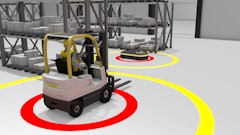
The new year signals significant developments in warehouse technology trends as companies settle in a post-pandemic environment. The primary drivers of these shifts are a continued labor shortage experienced by the industry in the last few years which has driven accelerated advancement of technology. A greater focus on robotics and automation has come to the forefront to fill the void left by a dwindling workforce.
The labor gap is only expected to increase in the next five years. Per Gartner, by 2028, there will be more smart robots than frontline workers in manufacturing, retail and logistics due to labor shortages. Companies must strategize how to fill the labor gap as we begin the new year, since labor shortages have become a big constraint on operational performances. In the near future, it’s not a question if companies will use automation to fill the employment gap but a question of when, where, and what and what an optimized collaboration looks like between humans and automation.
Furthermore, more companies are investing in cyber-physical automation due to labor availability issues, per Gartner, with over two million industrial robots already in use. So much of the focus is being put on the labor gap that supply chain leaders are investing in technology to drive employee engagement. By 2028, 40% of large warehouse operations will deploy employee engagement tools to motivate their workforces.
Automation subsystems are evolving rapidly, with the primary objective of maximizing efficiency while maintaining control and flexibility on warehouse floors. The trend is moving away from relying on a single system or vendor. Instead, it is shifting towards leveraging multiple subsystems and solutions from various vendors to optimize operational functionality and offset resource limitations.
In the realm of Warehouse Management Systems (WMS), the future is not about large, broad platform vendors. It is about more specialized, composable solutions tailored to specific operational and workflow needs. These solutions offer the flexibility to adapt to changing operational requirements quickly while having the capabilities of integrating new technologies seamlessly. With such solutions, customers are well-positioned to find the ideal combination that works best for their tailored business needs.
WMS leaders in the warehouse sector need to be at the forefront of these trends. With a focus on fulfillment solutions and providing tools for composability, WMS vendors are experts in navigating these changing market currents with minimal disruptions. They help increase productivity and offer cost-effective implementations by providing software that closely aligns with operational flows. The aim is to help customers achieve immediate and long-term value by offering software that aligns closely with their operations and business goals, thereby helping improve the bottom line.
Companies need a WMS partner that leads with a customer-focused approach and expertise in the warehouse market. Partnering with a warehouse solutions provider allows access to composability tools that easily connect automation subsystems and vendors without the need for coding. The ability to quickly adapt to changing market and consumer needs while continuously introducing new integration technologies is crucial in the evolving warehouse landscape, and that’s why it’s paramount to partner with the right warehouse solutions provider.
The warehouse trends for 2024 highlight a shift towards automation and specialized solutions to address labor shortages and maximize efficiency. With a focus on customer-specific needs and systems composability, experienced WMS solution providers are leaders in this evolving landscape and crucial to the success of any warehouse ecosystem.


























